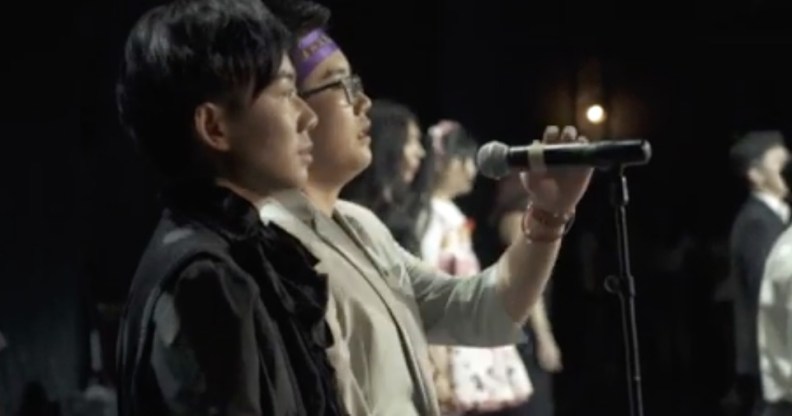Trans people are being excluded from choirs because of ‘cisgender expectations’ – but it doesn’t have to be this way

Members of a trans-positive choir sing onstage in China. (AFP)
Trans people are commonly excluded from choirs because of “cisgendered expectations” – but, as new research shows, change is possible.
Traditional, organised singing spaces, like choirs, are largely inaccessible to trans singers, who are denied access to these environments because sex and gender are expected to align and assumptions about vocal range are made accordingly.
But this doesn’t need to be the case. Alexander Pullinger, a classical singer whose partner is trans, found that making choirs a trans-positive space is possible with just a little education.
“For many singers who are transgender, organised singing has always been, and will remain, largely inaccessible,” Pullinger writes. “I was entirely unaware of this until very recently.”
“As far as I knew, I had never seen, nor worked with, any transgender singers: not as a boy chorister, nor as a choral scholar, nor anywhere on the freelance circuit in the UK and abroad. For a long time, the strangeness of this had not occurred to me.
“That is, until I made a connection between conventions in organised singing and the everyday challenges transgender individuals face – a connection I made as a result of being exposed to my (transgender) partner’s experiences in the wider world.
“I cannot now unsee the viscerally damaging effects of ignorant behaviour – whether it is overt or much more subtle – upon transgender people in singing environments. In either case, the harm is both acute and lasting.”
Pullinger’s research, funded by London charity Sound Connections, found that there are simple steps choirs can take to become more trans-positive.
He also found that including trans people in choirs could have significant positive benefits.
“I argue that the need to make singing more accessible to [trans singers] is urgent: not only because they are being unfairly excluded from an enjoyable pastime, but also because singing could directly help to alleviate the widespread mental health, body image and social isolation issues within the transgender community,” Pullinger says.
“In choral singing we frequently hear of ‘men’s’ voices (tenors and basses) and ‘women’s’ voices (sopranos and altos),” he explains.
“There are certain expectations that any given voice part will belong to a particular gender (‘men sing low, women sing high’). Although these expectations are not always met, they persist, despite major developments in our understanding of sex and gender since 1990.”
Pullinger adds that “voice type is a product of hormones and is not defined by gender”.
“For this reason, it can be concluded that assigning a gender to the voice in the way demonstrated by the conductor in my earlier anecdote (or in any way for that matter) does not make logical sense – even if it might seem simpler to do so.”
In conclusion, Pullinger writes that “a few targeted changes with regard to language, training, inclusion, and further research could bring about a major shift in perceptions about transgender people and their voices, within the world of music and also within wider society”.
Pullinger recommends choirs look at their dress codes and the gendered language used to make singing more accessible to trans people.
He continues: “There is even the possibility that the use of singing to champion and celebrate transgender voices could play a leading role in societal change, as constructive changes to the singing environment could have a widespread and lasting impact on the lives of a great many people.
“To achieve these changes, it is crucial for singing teachers and choral directors to be aware that voice type exists independently from gender.”

